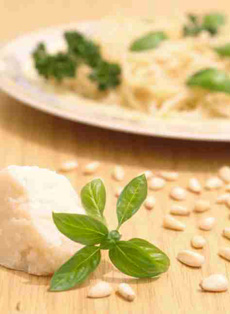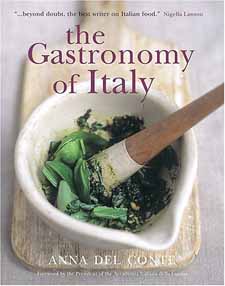

It all starts with basil, parmesan, pine nuts and olive oil.
|
ALISSA DICKER SCHRIEBER is a freelance writer and cooking teacher who resides in New York City.
|
|
January 2007
Updated March 2009
|
 |
The Best Pesto Sauce
Page 10: Pesto Tips
This is Page 10 of an 10-page review. Click on the black links below to visit other pages.
Pesto Tips
- Use the smallest leaves from the top of the basil plant—these will be the mildest. Larger leaves often develop a strong, minty taste, the last thing you want in pesto.
- Peeling away any thick spines from the leaves will also combat astringent flavor.
- Remove any green shoots from the middle of the garlic, as they can make your sauce bitter.
- Experts like Plotkin and Kummer recommend wiping rather than washing the leaves. This removes dirt from the surface and activates the herb’s fragrant oils without dampening its flavor and texture. However, it’s also fine to wash the leaves and dry them thoroughly in a salad spinner. This is especially advisable if your herbs may have been treated with chemical pesticides or fertilizers.
- If your leaves have some kick, you may need to balance that with by adding more of other ingredients (like nuts) for their mellowing effect. Be sure to taste as you mash so you can adjust accordingly when necessary, since pesto is all about balance.
- As for toasting the nuts, that’s up to you. Anna del Conte, British authority on Italian cuisine and author of the splendid Gastronomy of Italy, is a proponent of toasting, whereas Plotkin and Kummer use raw nuts. We tried both and neither disappoints—if you want more pronounced nuttiness, toast them in a 350°F oven for a few minutes; otherwise, raw ones work beautifully.
- If you use walnuts, Kummer suggests using half or two-thirds the amount of pine nuts the recipe calls for, as their taste is more pronounced.
Storing Pesto
When Ligurian fisherman would leave for long journeys at sea, they always packed along jars of pesto. You, too, can preserve your homemade and store-bought sauces. They’ll be ready for a great voyage—or a great meal.
- Pouring a layer of olive oil over the pesto will seal it from oxygen and inhibit browning and spoilage. It’s a good idea to replenish this layer as you use the pesto.
- Although homemade pesto sauce is most flavorful and fragrant at room temperature (many Italians store it in a cool dark cabinet), once it’s open, we’re more comfortable storing it in the refrigerator, where it should keep for at least a week.
- The perishable store-bought pestos that come in plastic containers should always be refrigerated, or, better yet, kept frozen. Just thaw 30-34 minutes on a countertop to soften, scoop out what you need, and re-freeze. This will ensure freshness while extending the life of your sauce.
- Any pesto can be frozen up to six months. Try pouring the sauce into ice cube trays, then storing the frozen cubes in a zip-lock freezer bag. You can toss one right into sauces or cooked pasta.
Books
The following books are terrific additions to your library and a wealth of information on pesto and recipes:
 Recipes From Paradise: Life and Food on the Italian Riviera, by Fred Plotkin Currently out of print, you can still purchase both new and used copies from resellers on Amazon.com. Click on the link for more information. Recipes From Paradise: Life and Food on the Italian Riviera, by Fred Plotkin Currently out of print, you can still purchase both new and used copies from resellers on Amazon.com. Click on the link for more information. - Italy for the Gourmet Traveler, by Fred Plotkin. Click on the link for more information or to purchase.
- Gastronomy of Italy, by Anna del Conte. Recipes and cooking reference, culinary and cultural history. Heavily illustrated with maps, diagrams, and color photographs. Click on the link for more information or to purchase.
Go To The Article Index Above
Lifestyle Direct, Inc. All rights reserved. Images are the copyright of their individual owners.

|





